Academic Skills Report: Climate Change Impacts on Nepal Agriculture
VerifiedAdded on 2022/09/09
|10
|2481
|14
Report
AI Summary
This report, authored by Sanjay Shrestha, investigates the significant impact of climate change on Nepal's agricultural sector. It begins with an introduction emphasizing the importance of agriculture to Nepal's economy, employment, and trade. The report defines climate change and its drivers, and then examines the geographical context of Nepal, including its diverse regions and climatic zones. The core of the report analyzes the adverse effects of climate change on crop production, highlighting the dependence of Nepalese agriculture on monsoon rains and the vulnerability of the sector to temperature changes, rainfall variations, and extreme weather events. The study also focuses on the southern Terai region, detailing the specific impacts on rice cultivation and the economic consequences. The report concludes by emphasizing the need for adaptation strategies to mitigate the negative effects of climate change on Nepal's agriculture, advocating for technological advancements and proactive measures to ensure food security and economic stability. It references various studies and surveys to support its findings, and provides a comprehensive overview of the issue.

Sanjay
Shresth
a
S2601036
Date:16 Dec
2019
Supervisor: Dr.
G. J. (Grace)
Rowicka
Course:
Academic Skills
Shresth
a
S2601036
Date:16 Dec
2019
Supervisor: Dr.
G. J. (Grace)
Rowicka
Course:
Academic Skills
Paraphrase This Document
Need a fresh take? Get an instant paraphrase of this document with our AI Paraphraser
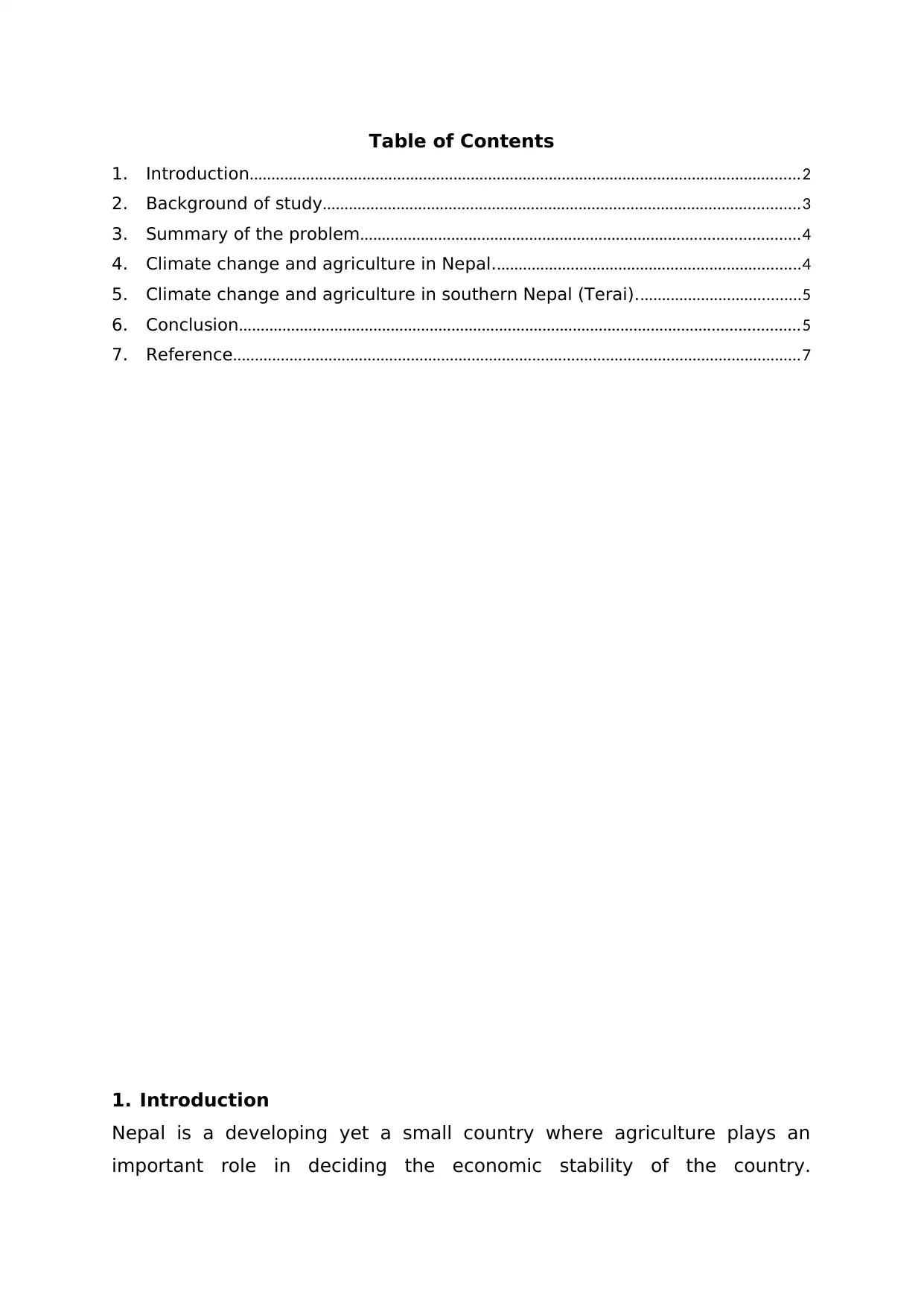
Table of Contents
1. Introduction...............................................................................................................................2
2. Background of study..............................................................................................................3
3. Summary of the problem.....................................................................................................4
4. Climate change and agriculture in Nepal.......................................................................4
5. Climate change and agriculture in southern Nepal (Terai)......................................5
6. Conclusion.................................................................................................................................5
7. Reference...................................................................................................................................7
1. Introduction
Nepal is a developing yet a small country where agriculture plays an
important role in deciding the economic stability of the country.
1. Introduction...............................................................................................................................2
2. Background of study..............................................................................................................3
3. Summary of the problem.....................................................................................................4
4. Climate change and agriculture in Nepal.......................................................................4
5. Climate change and agriculture in southern Nepal (Terai)......................................5
6. Conclusion.................................................................................................................................5
7. Reference...................................................................................................................................7
1. Introduction
Nepal is a developing yet a small country where agriculture plays an
important role in deciding the economic stability of the country.
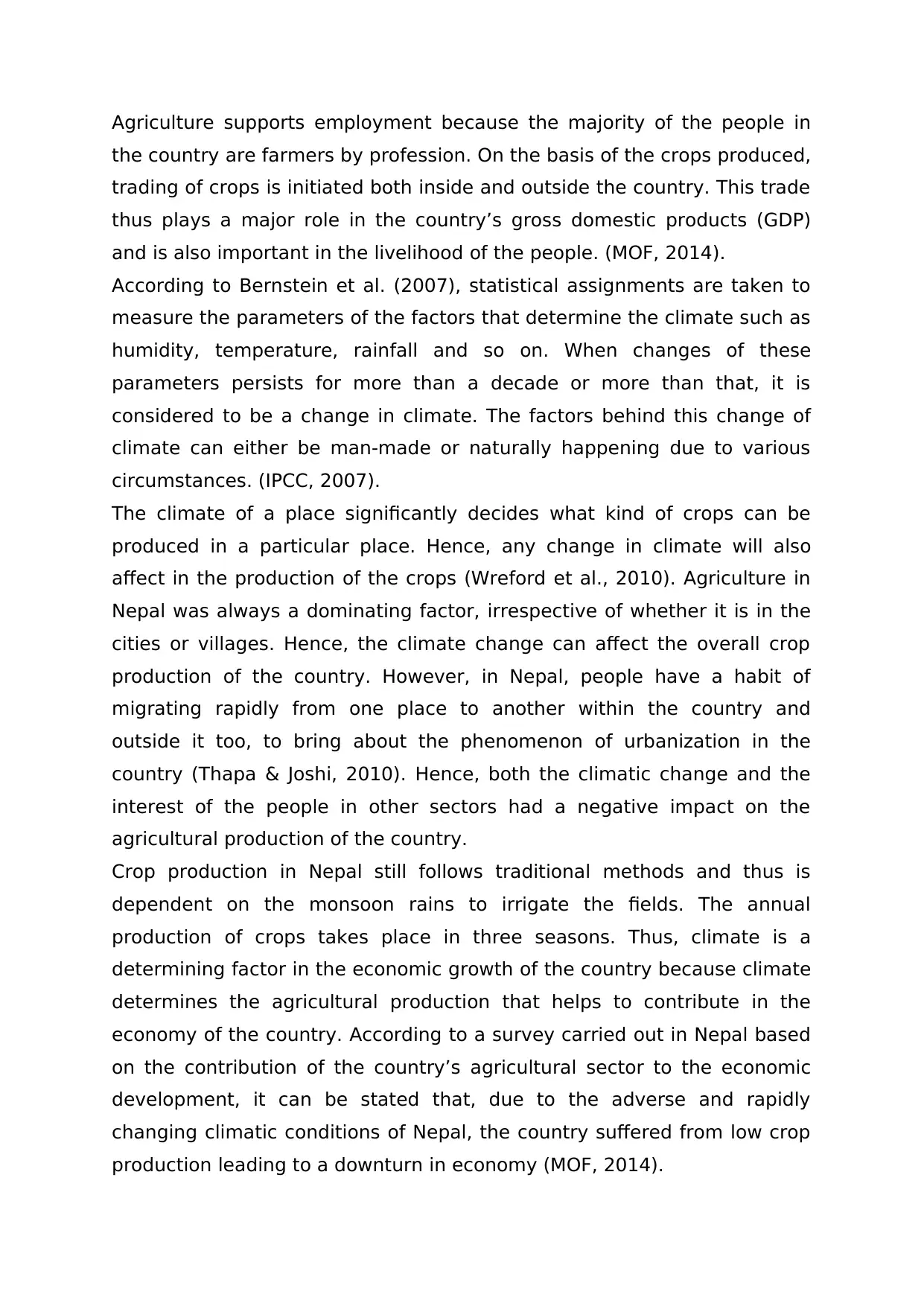
Agriculture supports employment because the majority of the people in
the country are farmers by profession. On the basis of the crops produced,
trading of crops is initiated both inside and outside the country. This trade
thus plays a major role in the country’s gross domestic products (GDP)
and is also important in the livelihood of the people. (MOF, 2014).
According to Bernstein et al. (2007), statistical assignments are taken to
measure the parameters of the factors that determine the climate such as
humidity, temperature, rainfall and so on. When changes of these
parameters persists for more than a decade or more than that, it is
considered to be a change in climate. The factors behind this change of
climate can either be man-made or naturally happening due to various
circumstances. (IPCC, 2007).
The climate of a place significantly decides what kind of crops can be
produced in a particular place. Hence, any change in climate will also
affect in the production of the crops (Wreford et al., 2010). Agriculture in
Nepal was always a dominating factor, irrespective of whether it is in the
cities or villages. Hence, the climate change can affect the overall crop
production of the country. However, in Nepal, people have a habit of
migrating rapidly from one place to another within the country and
outside it too, to bring about the phenomenon of urbanization in the
country (Thapa & Joshi, 2010). Hence, both the climatic change and the
interest of the people in other sectors had a negative impact on the
agricultural production of the country.
Crop production in Nepal still follows traditional methods and thus is
dependent on the monsoon rains to irrigate the fields. The annual
production of crops takes place in three seasons. Thus, climate is a
determining factor in the economic growth of the country because climate
determines the agricultural production that helps to contribute in the
economy of the country. According to a survey carried out in Nepal based
on the contribution of the country’s agricultural sector to the economic
development, it can be stated that, due to the adverse and rapidly
changing climatic conditions of Nepal, the country suffered from low crop
production leading to a downturn in economy (MOF, 2014).
the country are farmers by profession. On the basis of the crops produced,
trading of crops is initiated both inside and outside the country. This trade
thus plays a major role in the country’s gross domestic products (GDP)
and is also important in the livelihood of the people. (MOF, 2014).
According to Bernstein et al. (2007), statistical assignments are taken to
measure the parameters of the factors that determine the climate such as
humidity, temperature, rainfall and so on. When changes of these
parameters persists for more than a decade or more than that, it is
considered to be a change in climate. The factors behind this change of
climate can either be man-made or naturally happening due to various
circumstances. (IPCC, 2007).
The climate of a place significantly decides what kind of crops can be
produced in a particular place. Hence, any change in climate will also
affect in the production of the crops (Wreford et al., 2010). Agriculture in
Nepal was always a dominating factor, irrespective of whether it is in the
cities or villages. Hence, the climate change can affect the overall crop
production of the country. However, in Nepal, people have a habit of
migrating rapidly from one place to another within the country and
outside it too, to bring about the phenomenon of urbanization in the
country (Thapa & Joshi, 2010). Hence, both the climatic change and the
interest of the people in other sectors had a negative impact on the
agricultural production of the country.
Crop production in Nepal still follows traditional methods and thus is
dependent on the monsoon rains to irrigate the fields. The annual
production of crops takes place in three seasons. Thus, climate is a
determining factor in the economic growth of the country because climate
determines the agricultural production that helps to contribute in the
economy of the country. According to a survey carried out in Nepal based
on the contribution of the country’s agricultural sector to the economic
development, it can be stated that, due to the adverse and rapidly
changing climatic conditions of Nepal, the country suffered from low crop
production leading to a downturn in economy (MOF, 2014).
⊘ This is a preview!⊘
Do you want full access?
Subscribe today to unlock all pages.

Trusted by 1+ million students worldwide
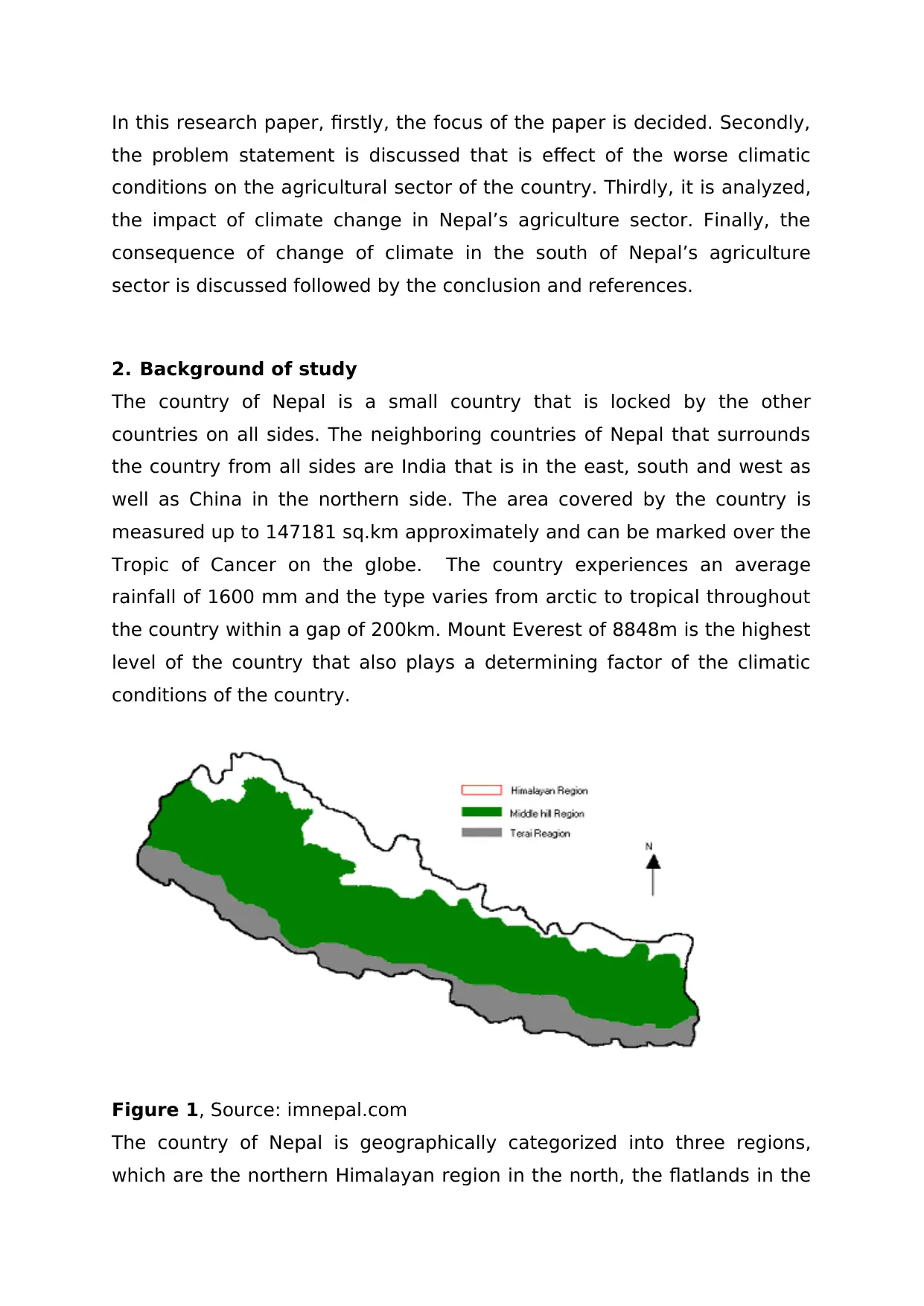
In this research paper, firstly, the focus of the paper is decided. Secondly,
the problem statement is discussed that is effect of the worse climatic
conditions on the agricultural sector of the country. Thirdly, it is analyzed,
the impact of climate change in Nepal’s agriculture sector. Finally, the
consequence of change of climate in the south of Nepal’s agriculture
sector is discussed followed by the conclusion and references.
2. Background of study
The country of Nepal is a small country that is locked by the other
countries on all sides. The neighboring countries of Nepal that surrounds
the country from all sides are India that is in the east, south and west as
well as China in the northern side. The area covered by the country is
measured up to 147181 sq.km approximately and can be marked over the
Tropic of Cancer on the globe. The country experiences an average
rainfall of 1600 mm and the type varies from arctic to tropical throughout
the country within a gap of 200km. Mount Everest of 8848m is the highest
level of the country that also plays a determining factor of the climatic
conditions of the country.
Figure 1, Source: imnepal.com
The country of Nepal is geographically categorized into three regions,
which are the northern Himalayan region in the north, the flatlands in the
the problem statement is discussed that is effect of the worse climatic
conditions on the agricultural sector of the country. Thirdly, it is analyzed,
the impact of climate change in Nepal’s agriculture sector. Finally, the
consequence of change of climate in the south of Nepal’s agriculture
sector is discussed followed by the conclusion and references.
2. Background of study
The country of Nepal is a small country that is locked by the other
countries on all sides. The neighboring countries of Nepal that surrounds
the country from all sides are India that is in the east, south and west as
well as China in the northern side. The area covered by the country is
measured up to 147181 sq.km approximately and can be marked over the
Tropic of Cancer on the globe. The country experiences an average
rainfall of 1600 mm and the type varies from arctic to tropical throughout
the country within a gap of 200km. Mount Everest of 8848m is the highest
level of the country that also plays a determining factor of the climatic
conditions of the country.
Figure 1, Source: imnepal.com
The country of Nepal is geographically categorized into three regions,
which are the northern Himalayan region in the north, the flatlands in the
Paraphrase This Document
Need a fresh take? Get an instant paraphrase of this document with our AI Paraphraser
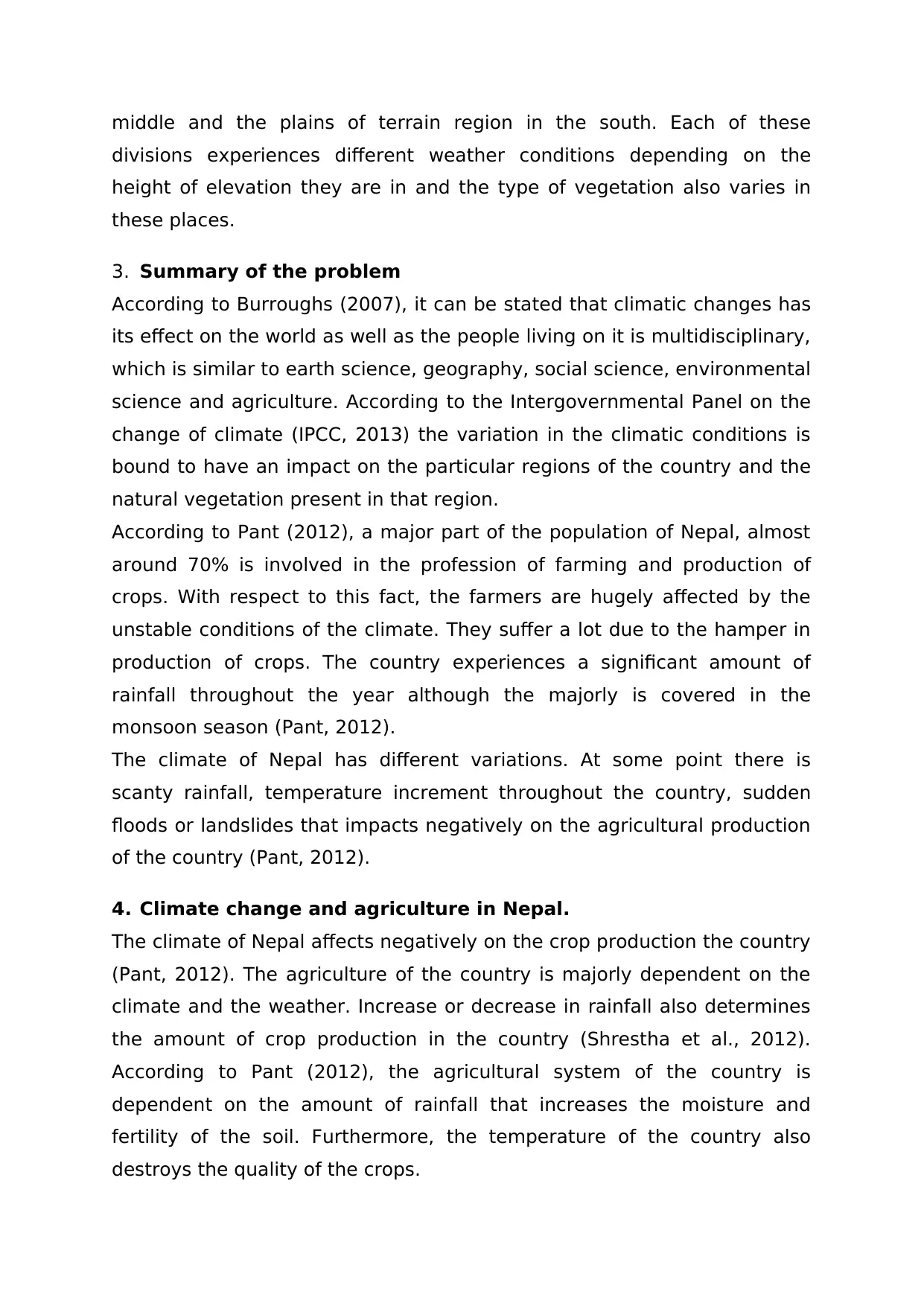
middle and the plains of terrain region in the south. Each of these
divisions experiences different weather conditions depending on the
height of elevation they are in and the type of vegetation also varies in
these places.
3. Summary of the problem
According to Burroughs (2007), it can be stated that climatic changes has
its effect on the world as well as the people living on it is multidisciplinary,
which is similar to earth science, geography, social science, environmental
science and agriculture. According to the Intergovernmental Panel on the
change of climate (IPCC, 2013) the variation in the climatic conditions is
bound to have an impact on the particular regions of the country and the
natural vegetation present in that region.
According to Pant (2012), a major part of the population of Nepal, almost
around 70% is involved in the profession of farming and production of
crops. With respect to this fact, the farmers are hugely affected by the
unstable conditions of the climate. They suffer a lot due to the hamper in
production of crops. The country experiences a significant amount of
rainfall throughout the year although the majorly is covered in the
monsoon season (Pant, 2012).
The climate of Nepal has different variations. At some point there is
scanty rainfall, temperature increment throughout the country, sudden
floods or landslides that impacts negatively on the agricultural production
of the country (Pant, 2012).
4. Climate change and agriculture in Nepal.
The climate of Nepal affects negatively on the crop production the country
(Pant, 2012). The agriculture of the country is majorly dependent on the
climate and the weather. Increase or decrease in rainfall also determines
the amount of crop production in the country (Shrestha et al., 2012).
According to Pant (2012), the agricultural system of the country is
dependent on the amount of rainfall that increases the moisture and
fertility of the soil. Furthermore, the temperature of the country also
destroys the quality of the crops.
divisions experiences different weather conditions depending on the
height of elevation they are in and the type of vegetation also varies in
these places.
3. Summary of the problem
According to Burroughs (2007), it can be stated that climatic changes has
its effect on the world as well as the people living on it is multidisciplinary,
which is similar to earth science, geography, social science, environmental
science and agriculture. According to the Intergovernmental Panel on the
change of climate (IPCC, 2013) the variation in the climatic conditions is
bound to have an impact on the particular regions of the country and the
natural vegetation present in that region.
According to Pant (2012), a major part of the population of Nepal, almost
around 70% is involved in the profession of farming and production of
crops. With respect to this fact, the farmers are hugely affected by the
unstable conditions of the climate. They suffer a lot due to the hamper in
production of crops. The country experiences a significant amount of
rainfall throughout the year although the majorly is covered in the
monsoon season (Pant, 2012).
The climate of Nepal has different variations. At some point there is
scanty rainfall, temperature increment throughout the country, sudden
floods or landslides that impacts negatively on the agricultural production
of the country (Pant, 2012).
4. Climate change and agriculture in Nepal.
The climate of Nepal affects negatively on the crop production the country
(Pant, 2012). The agriculture of the country is majorly dependent on the
climate and the weather. Increase or decrease in rainfall also determines
the amount of crop production in the country (Shrestha et al., 2012).
According to Pant (2012), the agricultural system of the country is
dependent on the amount of rainfall that increases the moisture and
fertility of the soil. Furthermore, the temperature of the country also
destroys the quality of the crops.
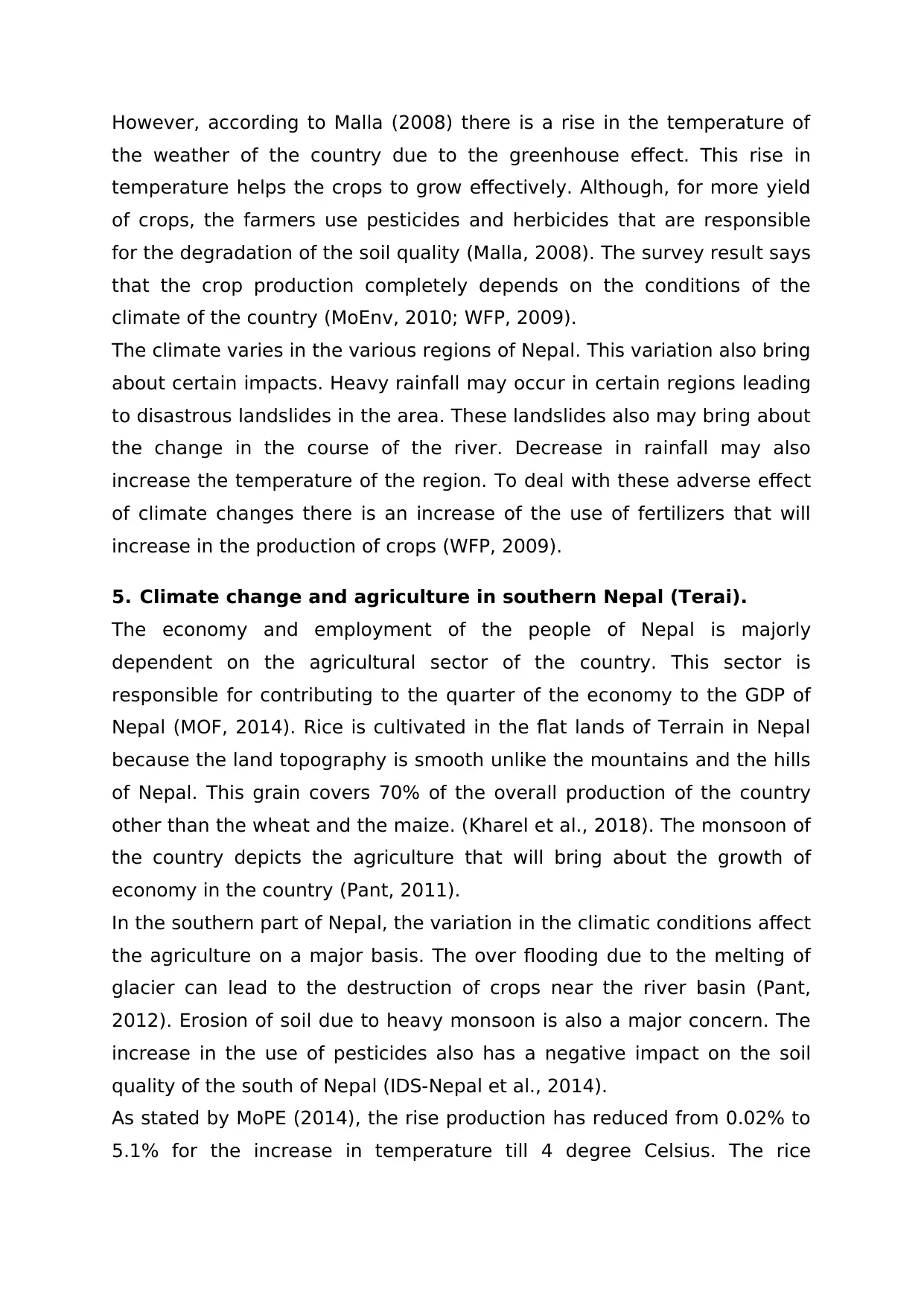
However, according to Malla (2008) there is a rise in the temperature of
the weather of the country due to the greenhouse effect. This rise in
temperature helps the crops to grow effectively. Although, for more yield
of crops, the farmers use pesticides and herbicides that are responsible
for the degradation of the soil quality (Malla, 2008). The survey result says
that the crop production completely depends on the conditions of the
climate of the country (MoEnv, 2010; WFP, 2009).
The climate varies in the various regions of Nepal. This variation also bring
about certain impacts. Heavy rainfall may occur in certain regions leading
to disastrous landslides in the area. These landslides also may bring about
the change in the course of the river. Decrease in rainfall may also
increase the temperature of the region. To deal with these adverse effect
of climate changes there is an increase of the use of fertilizers that will
increase in the production of crops (WFP, 2009).
5. Climate change and agriculture in southern Nepal (Terai).
The economy and employment of the people of Nepal is majorly
dependent on the agricultural sector of the country. This sector is
responsible for contributing to the quarter of the economy to the GDP of
Nepal (MOF, 2014). Rice is cultivated in the flat lands of Terrain in Nepal
because the land topography is smooth unlike the mountains and the hills
of Nepal. This grain covers 70% of the overall production of the country
other than the wheat and the maize. (Kharel et al., 2018). The monsoon of
the country depicts the agriculture that will bring about the growth of
economy in the country (Pant, 2011).
In the southern part of Nepal, the variation in the climatic conditions affect
the agriculture on a major basis. The over flooding due to the melting of
glacier can lead to the destruction of crops near the river basin (Pant,
2012). Erosion of soil due to heavy monsoon is also a major concern. The
increase in the use of pesticides also has a negative impact on the soil
quality of the south of Nepal (IDS-Nepal et al., 2014).
As stated by MoPE (2014), the rise production has reduced from 0.02% to
5.1% for the increase in temperature till 4 degree Celsius. The rice
the weather of the country due to the greenhouse effect. This rise in
temperature helps the crops to grow effectively. Although, for more yield
of crops, the farmers use pesticides and herbicides that are responsible
for the degradation of the soil quality (Malla, 2008). The survey result says
that the crop production completely depends on the conditions of the
climate of the country (MoEnv, 2010; WFP, 2009).
The climate varies in the various regions of Nepal. This variation also bring
about certain impacts. Heavy rainfall may occur in certain regions leading
to disastrous landslides in the area. These landslides also may bring about
the change in the course of the river. Decrease in rainfall may also
increase the temperature of the region. To deal with these adverse effect
of climate changes there is an increase of the use of fertilizers that will
increase in the production of crops (WFP, 2009).
5. Climate change and agriculture in southern Nepal (Terai).
The economy and employment of the people of Nepal is majorly
dependent on the agricultural sector of the country. This sector is
responsible for contributing to the quarter of the economy to the GDP of
Nepal (MOF, 2014). Rice is cultivated in the flat lands of Terrain in Nepal
because the land topography is smooth unlike the mountains and the hills
of Nepal. This grain covers 70% of the overall production of the country
other than the wheat and the maize. (Kharel et al., 2018). The monsoon of
the country depicts the agriculture that will bring about the growth of
economy in the country (Pant, 2011).
In the southern part of Nepal, the variation in the climatic conditions affect
the agriculture on a major basis. The over flooding due to the melting of
glacier can lead to the destruction of crops near the river basin (Pant,
2012). Erosion of soil due to heavy monsoon is also a major concern. The
increase in the use of pesticides also has a negative impact on the soil
quality of the south of Nepal (IDS-Nepal et al., 2014).
As stated by MoPE (2014), the rise production has reduced from 0.02% to
5.1% for the increase in temperature till 4 degree Celsius. The rice
⊘ This is a preview!⊘
Do you want full access?
Subscribe today to unlock all pages.

Trusted by 1+ million students worldwide
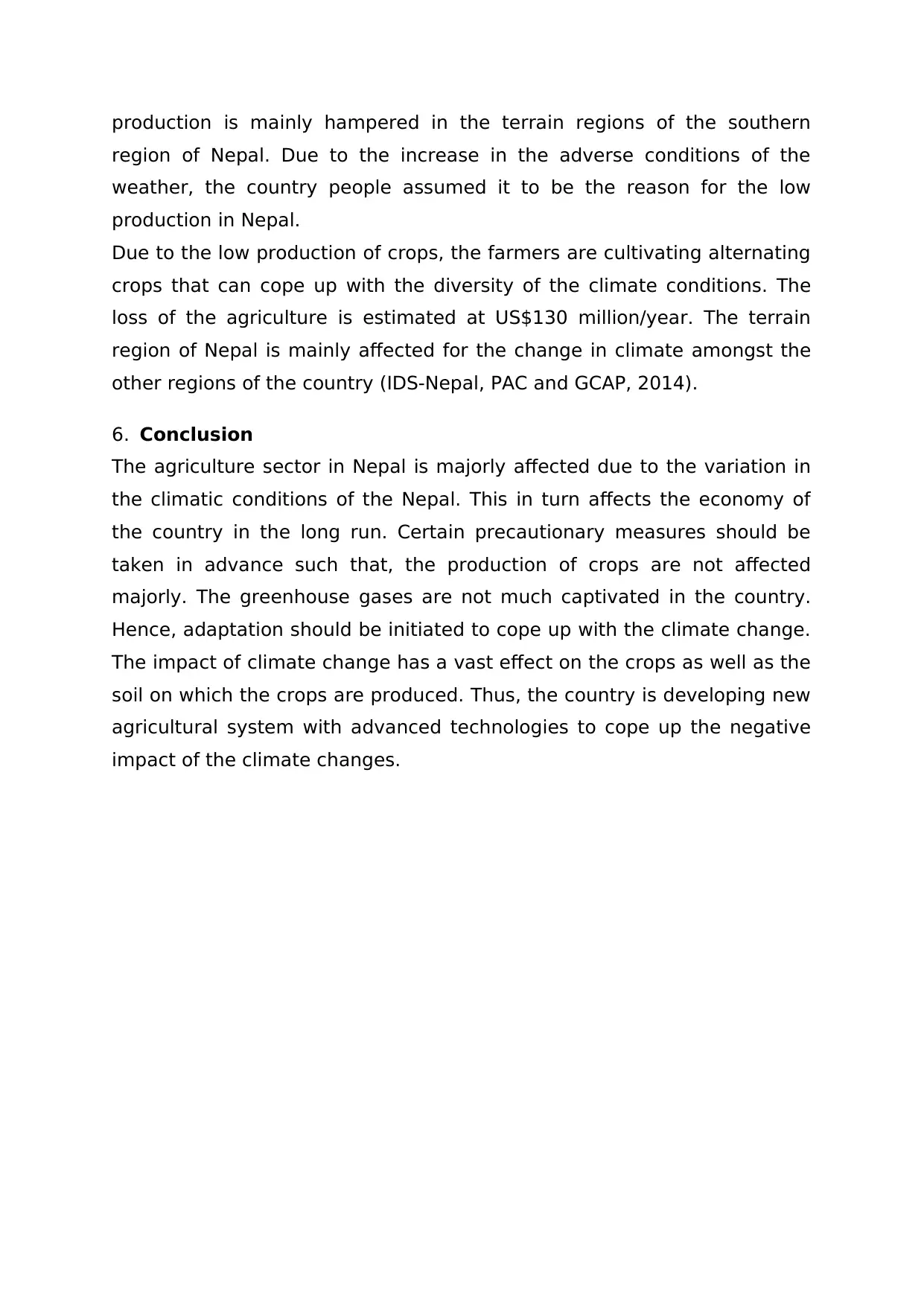
production is mainly hampered in the terrain regions of the southern
region of Nepal. Due to the increase in the adverse conditions of the
weather, the country people assumed it to be the reason for the low
production in Nepal.
Due to the low production of crops, the farmers are cultivating alternating
crops that can cope up with the diversity of the climate conditions. The
loss of the agriculture is estimated at US$130 million/year. The terrain
region of Nepal is mainly affected for the change in climate amongst the
other regions of the country (IDS-Nepal, PAC and GCAP, 2014).
6. Conclusion
The agriculture sector in Nepal is majorly affected due to the variation in
the climatic conditions of the Nepal. This in turn affects the economy of
the country in the long run. Certain precautionary measures should be
taken in advance such that, the production of crops are not affected
majorly. The greenhouse gases are not much captivated in the country.
Hence, adaptation should be initiated to cope up with the climate change.
The impact of climate change has a vast effect on the crops as well as the
soil on which the crops are produced. Thus, the country is developing new
agricultural system with advanced technologies to cope up the negative
impact of the climate changes.
region of Nepal. Due to the increase in the adverse conditions of the
weather, the country people assumed it to be the reason for the low
production in Nepal.
Due to the low production of crops, the farmers are cultivating alternating
crops that can cope up with the diversity of the climate conditions. The
loss of the agriculture is estimated at US$130 million/year. The terrain
region of Nepal is mainly affected for the change in climate amongst the
other regions of the country (IDS-Nepal, PAC and GCAP, 2014).
6. Conclusion
The agriculture sector in Nepal is majorly affected due to the variation in
the climatic conditions of the Nepal. This in turn affects the economy of
the country in the long run. Certain precautionary measures should be
taken in advance such that, the production of crops are not affected
majorly. The greenhouse gases are not much captivated in the country.
Hence, adaptation should be initiated to cope up with the climate change.
The impact of climate change has a vast effect on the crops as well as the
soil on which the crops are produced. Thus, the country is developing new
agricultural system with advanced technologies to cope up the negative
impact of the climate changes.
Paraphrase This Document
Need a fresh take? Get an instant paraphrase of this document with our AI Paraphraser
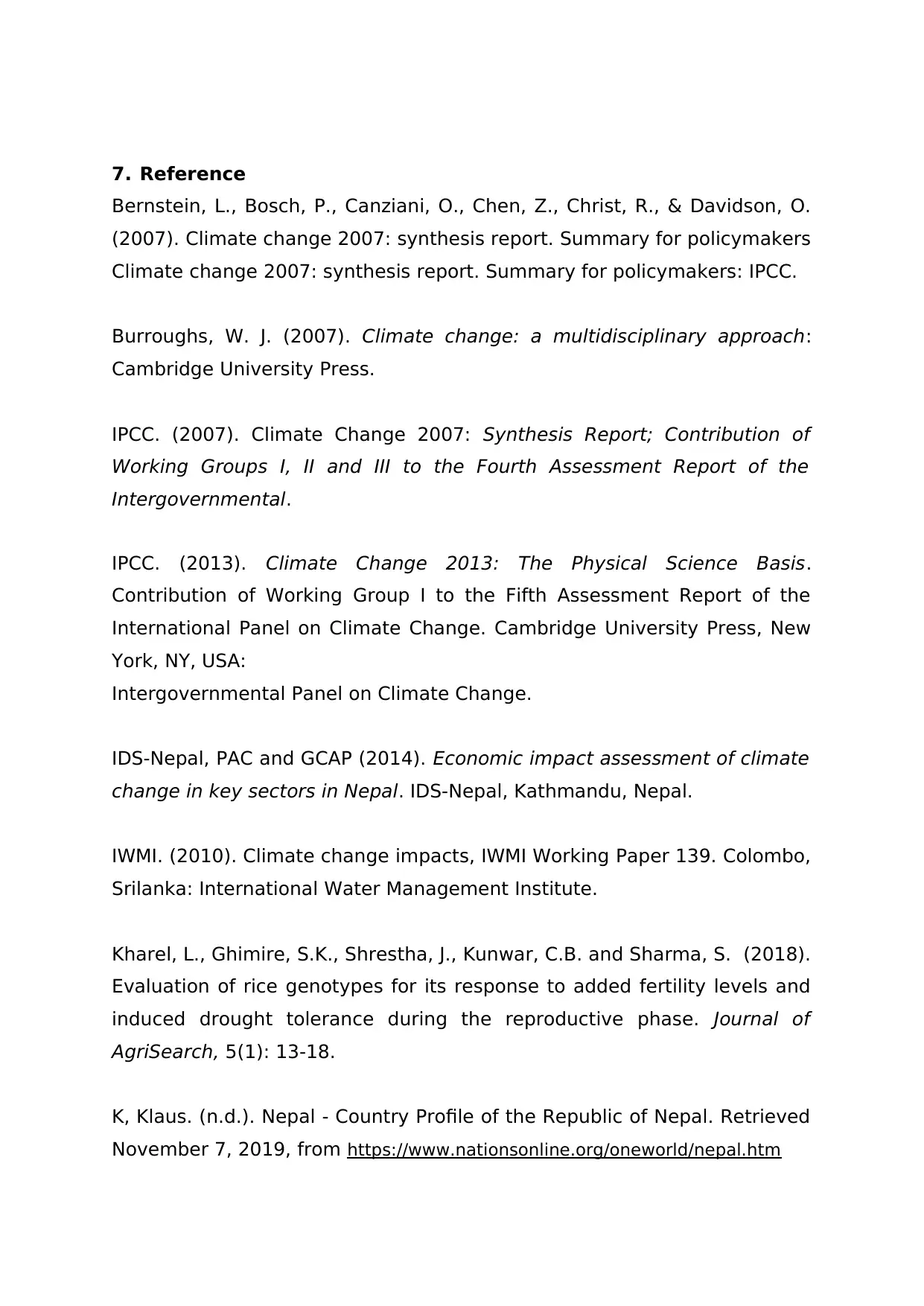
7. Reference
Bernstein, L., Bosch, P., Canziani, O., Chen, Z., Christ, R., & Davidson, O.
(2007). Climate change 2007: synthesis report. Summary for policymakers
Climate change 2007: synthesis report. Summary for policymakers: IPCC.
Burroughs, W. J. (2007). Climate change: a multidisciplinary approach:
Cambridge University Press.
IPCC. (2007). Climate Change 2007: Synthesis Report; Contribution of
Working Groups I, II and III to the Fourth Assessment Report of the
Intergovernmental.
IPCC. (2013). Climate Change 2013: The Physical Science Basis.
Contribution of Working Group I to the Fifth Assessment Report of the
International Panel on Climate Change. Cambridge University Press, New
York, NY, USA:
Intergovernmental Panel on Climate Change.
IDS-Nepal, PAC and GCAP (2014). Economic impact assessment of climate
change in key sectors in Nepal. IDS-Nepal, Kathmandu, Nepal.
IWMI. (2010). Climate change impacts, IWMI Working Paper 139. Colombo,
Srilanka: International Water Management Institute.
Kharel, L., Ghimire, S.K., Shrestha, J., Kunwar, C.B. and Sharma, S. (2018).
Evaluation of rice genotypes for its response to added fertility levels and
induced drought tolerance during the reproductive phase. Journal of
AgriSearch, 5(1): 13-18.
K, Klaus. (n.d.). Nepal - Country Profile of the Republic of Nepal. Retrieved
November 7, 2019, from https://www.nationsonline.org/oneworld/nepal.htm
Bernstein, L., Bosch, P., Canziani, O., Chen, Z., Christ, R., & Davidson, O.
(2007). Climate change 2007: synthesis report. Summary for policymakers
Climate change 2007: synthesis report. Summary for policymakers: IPCC.
Burroughs, W. J. (2007). Climate change: a multidisciplinary approach:
Cambridge University Press.
IPCC. (2007). Climate Change 2007: Synthesis Report; Contribution of
Working Groups I, II and III to the Fourth Assessment Report of the
Intergovernmental.
IPCC. (2013). Climate Change 2013: The Physical Science Basis.
Contribution of Working Group I to the Fifth Assessment Report of the
International Panel on Climate Change. Cambridge University Press, New
York, NY, USA:
Intergovernmental Panel on Climate Change.
IDS-Nepal, PAC and GCAP (2014). Economic impact assessment of climate
change in key sectors in Nepal. IDS-Nepal, Kathmandu, Nepal.
IWMI. (2010). Climate change impacts, IWMI Working Paper 139. Colombo,
Srilanka: International Water Management Institute.
Kharel, L., Ghimire, S.K., Shrestha, J., Kunwar, C.B. and Sharma, S. (2018).
Evaluation of rice genotypes for its response to added fertility levels and
induced drought tolerance during the reproductive phase. Journal of
AgriSearch, 5(1): 13-18.
K, Klaus. (n.d.). Nepal - Country Profile of the Republic of Nepal. Retrieved
November 7, 2019, from https://www.nationsonline.org/oneworld/nepal.htm
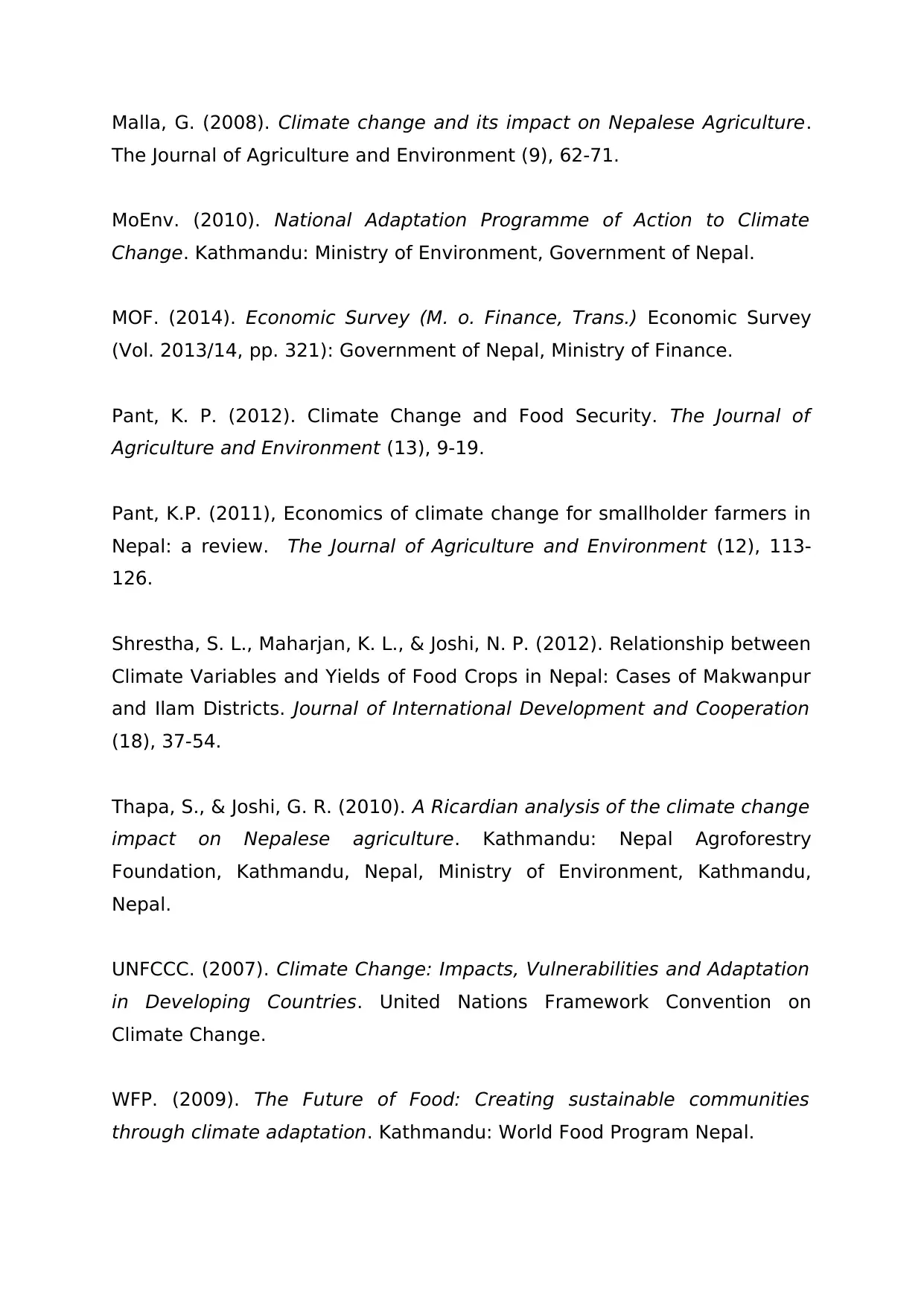
Malla, G. (2008). Climate change and its impact on Nepalese Agriculture.
The Journal of Agriculture and Environment (9), 62-71.
MoEnv. (2010). National Adaptation Programme of Action to Climate
Change. Kathmandu: Ministry of Environment, Government of Nepal.
MOF. (2014). Economic Survey (M. o. Finance, Trans.) Economic Survey
(Vol. 2013/14, pp. 321): Government of Nepal, Ministry of Finance.
Pant, K. P. (2012). Climate Change and Food Security. The Journal of
Agriculture and Environment (13), 9-19.
Pant, K.P. (2011), Economics of climate change for smallholder farmers in
Nepal: a review. The Journal of Agriculture and Environment (12), 113-
126.
Shrestha, S. L., Maharjan, K. L., & Joshi, N. P. (2012). Relationship between
Climate Variables and Yields of Food Crops in Nepal: Cases of Makwanpur
and Ilam Districts. Journal of International Development and Cooperation
(18), 37-54.
Thapa, S., & Joshi, G. R. (2010). A Ricardian analysis of the climate change
impact on Nepalese agriculture. Kathmandu: Nepal Agroforestry
Foundation, Kathmandu, Nepal, Ministry of Environment, Kathmandu,
Nepal.
UNFCCC. (2007). Climate Change: Impacts, Vulnerabilities and Adaptation
in Developing Countries. United Nations Framework Convention on
Climate Change.
WFP. (2009). The Future of Food: Creating sustainable communities
through climate adaptation. Kathmandu: World Food Program Nepal.
The Journal of Agriculture and Environment (9), 62-71.
MoEnv. (2010). National Adaptation Programme of Action to Climate
Change. Kathmandu: Ministry of Environment, Government of Nepal.
MOF. (2014). Economic Survey (M. o. Finance, Trans.) Economic Survey
(Vol. 2013/14, pp. 321): Government of Nepal, Ministry of Finance.
Pant, K. P. (2012). Climate Change and Food Security. The Journal of
Agriculture and Environment (13), 9-19.
Pant, K.P. (2011), Economics of climate change for smallholder farmers in
Nepal: a review. The Journal of Agriculture and Environment (12), 113-
126.
Shrestha, S. L., Maharjan, K. L., & Joshi, N. P. (2012). Relationship between
Climate Variables and Yields of Food Crops in Nepal: Cases of Makwanpur
and Ilam Districts. Journal of International Development and Cooperation
(18), 37-54.
Thapa, S., & Joshi, G. R. (2010). A Ricardian analysis of the climate change
impact on Nepalese agriculture. Kathmandu: Nepal Agroforestry
Foundation, Kathmandu, Nepal, Ministry of Environment, Kathmandu,
Nepal.
UNFCCC. (2007). Climate Change: Impacts, Vulnerabilities and Adaptation
in Developing Countries. United Nations Framework Convention on
Climate Change.
WFP. (2009). The Future of Food: Creating sustainable communities
through climate adaptation. Kathmandu: World Food Program Nepal.
⊘ This is a preview!⊘
Do you want full access?
Subscribe today to unlock all pages.

Trusted by 1+ million students worldwide
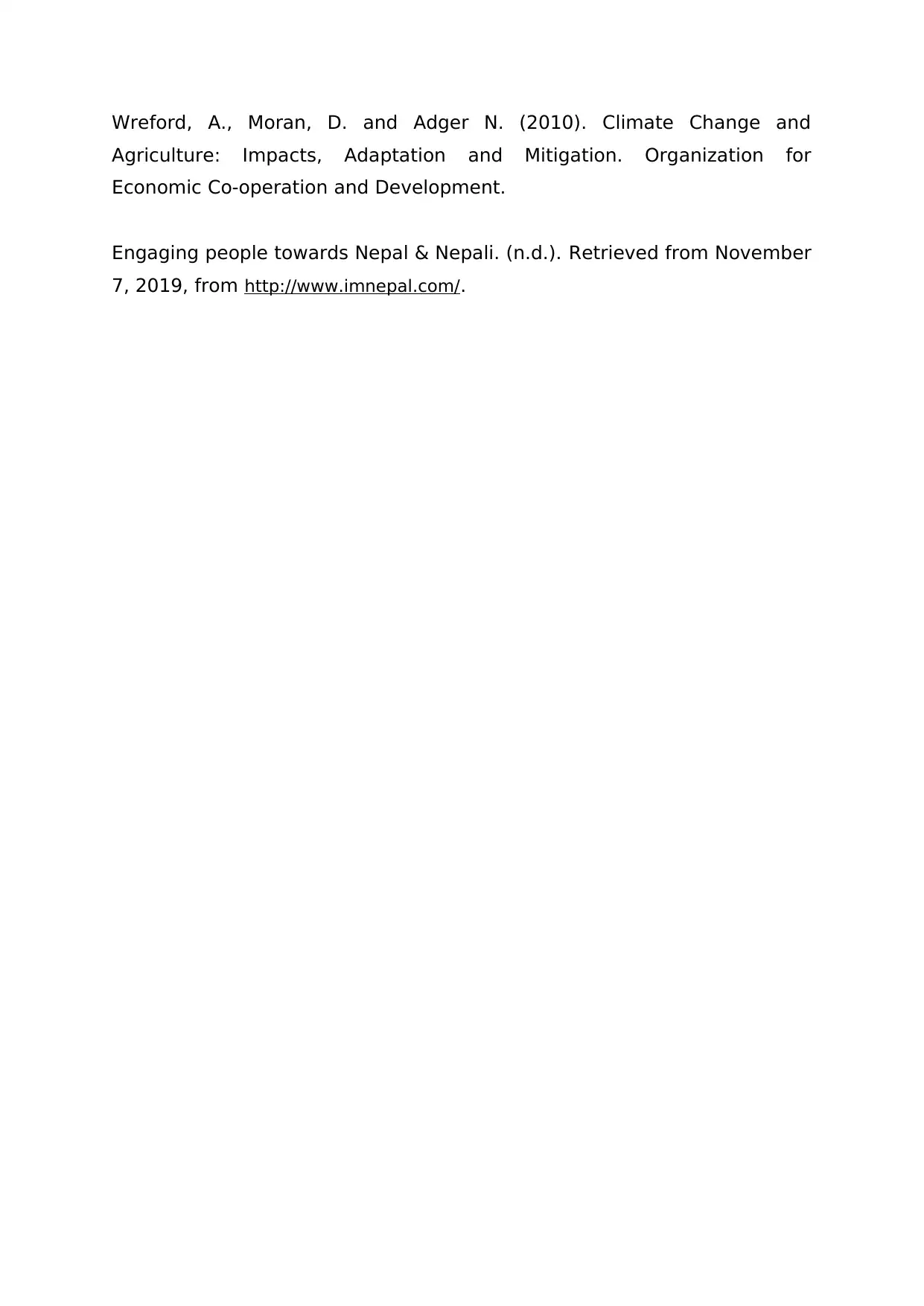
Wreford, A., Moran, D. and Adger N. (2010). Climate Change and
Agriculture: Impacts, Adaptation and Mitigation. Organization for
Economic Co-operation and Development.
Engaging people towards Nepal & Nepali. (n.d.). Retrieved from November
7, 2019, from http://www.imnepal.com/.
Agriculture: Impacts, Adaptation and Mitigation. Organization for
Economic Co-operation and Development.
Engaging people towards Nepal & Nepali. (n.d.). Retrieved from November
7, 2019, from http://www.imnepal.com/.
1 out of 10
Your All-in-One AI-Powered Toolkit for Academic Success.
+13062052269
info@desklib.com
Available 24*7 on WhatsApp / Email
![[object Object]](/_next/static/media/star-bottom.7253800d.svg)
Unlock your academic potential
Copyright © 2020–2025 A2Z Services. All Rights Reserved. Developed and managed by ZUCOL.